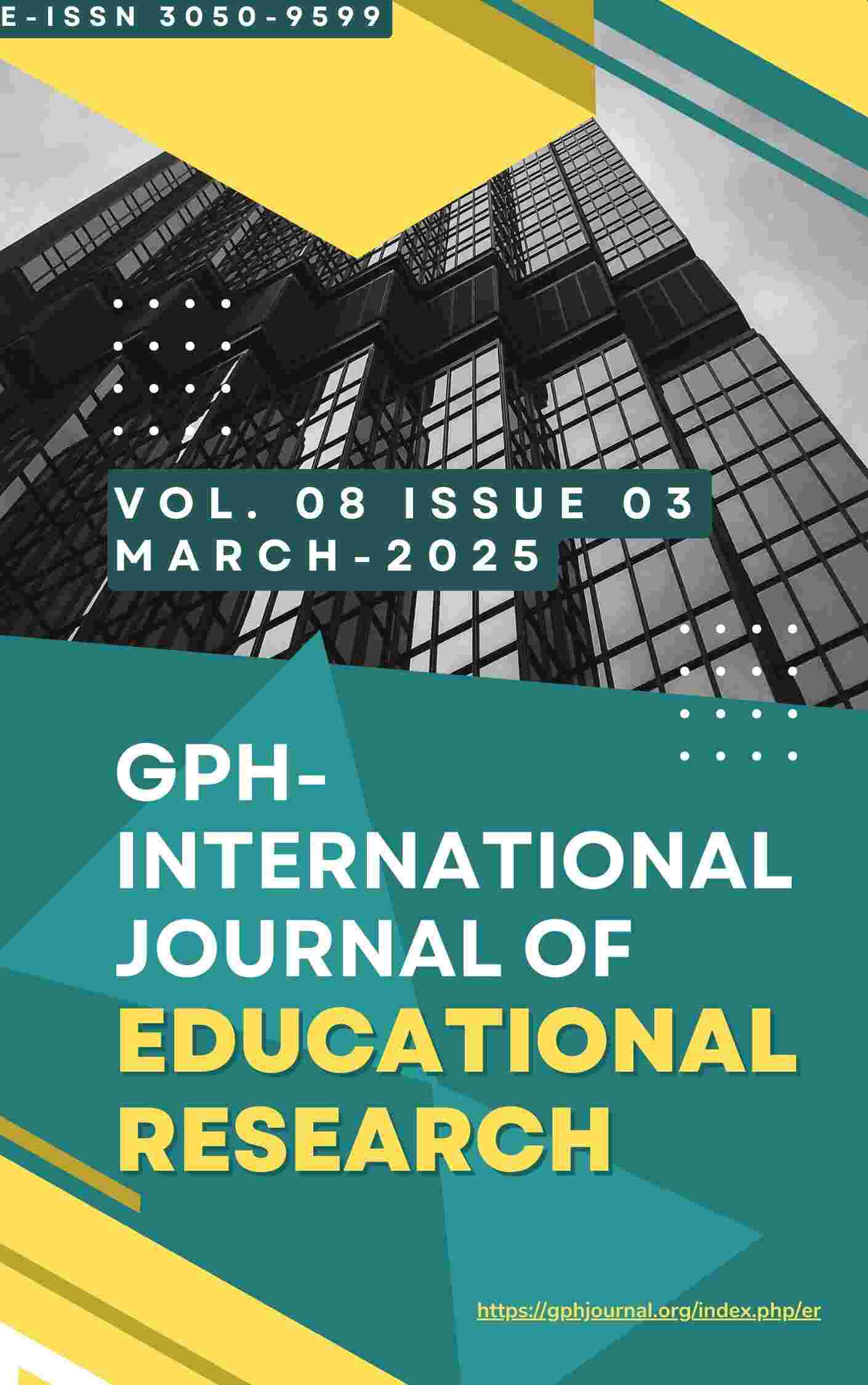An Appraisal of the Use of Technology in the Acquisition of English as a Second Language
Abstract
The study provides an overview of the utilization of technology in Second Language Acquisition (SLA), particularly focusing on the use of Artificial Intelligence (AI), Digital Technologies (AR/VR), and other applications (Apps) and online resources. It examines their incorporation, benefits, and challenges to project future directions. As the research reveals, English is spoken as a second language in many parts of the world, and technology has been crucial to enhancing knowledge through a learner-centered approach, though not without some psychological, environmental, ethical, and pedagogical concerns and challenges. Utilizing a review research design and drawing from existing studies, this paper discusses various technological tools, their current use in SLA, and future directions. It recommends involving English experts in the development of technological tools for better outcomes, and that governments should facilitate and enforce technology-driven education, incorporating it into national language policy on education. It concludes that learners, especially teenagers and young adults, should be guided on the use of technology in SLA, aiming for competence in language use. It establishes that the advent of technology has revolutionized Second Language Acquisition, and its integration in SLA has offered unparalleled opportunities for language learning and instruction.
Downloads
References
Adigun, G. and Oladapo, Y. (2024). Legal and Ethical Issues in Information Use. In Library Handbook for Library Students, LAUTECH, Ogbomoso.
Adebileje, A. & Akinola, A. 2020. Teaching and Learning English as a Second Language in Nigeria: Examining Evolving Approaches and Methods. In Theory and Practice in Language. Vol. 10. DOI- 10.17507/tpls.1009.02
Algeo, J. (2010). The Origins and Development of the English Language (6th Ed.). Wadsworth: Cengage Learning.
Belpaeme, T., & Tanaka, F. (2022). Social Robots as Educators. Retrieved April 10, 2024from https://www.oecd-ilibrary.org/sites/1c3b1d56 en/index.html?itemId=/content/component/1c3b1d56-en#section-d1e17138- 3fa1249ab7
Bloom, L. (2003). The Transition from Infancy to Language: acquiring the power of expression. Cambridge: Cambridge University Press.
Chen B, Wang Y, Wang L. (2022). The effects of virtual reality-assisted language learning: A meta-analysis. Sustainability: 14(6):3147. doi: 10.3390/su14063147.
Crystal, D. (2003). English as a global language. Cambridge: Cambridge University Press.
Culpepper, J. (2000). History of English. London: Routledge.
Digital Humanities: Application of Computer to the Arts. 2024. A Course Guide for Faculty of Arts and Social Sciences, LAUTECH, Ogbomoso.
ENG 151: Introduction to English as a Second Language (Course Guide). National Open University of Nigeria, School of Arts and Social Sciences. Lagos.
Garzón, J., Pavón, J. &Baldiris, S. (2019). Systematic review and meta-analysis of augmented reality in educational settings. Virtual Real. 23, 447–459.
Garzón, J., Baldiris, S., Gutiérrez, J., & Pavón, J. (2020). How do pedagogical approaches affect the impact of augmented reality on education? A meta-analysis and research synthesis. Educational Research Review, 100334. 10.1016/j.edurev.2020.100334.
Graddol, D. (1997). The Future of English. London: British Council.
Haleem, A., Javaid, M., Qadri, M. and Suman, R. 2022. Understanding the role of digitaltechnologies in education: A review. In Sustainable Operations and Computers. Vol. 3, Pp. 275-285.
History of English Language (ENG 1C03) Study Material, University of Calicut, School of Distance Education
Holmes, J. (2013). An Introduction to Sociolinguistics (4th Ed.) London: Routledge.
Lampropoulos, G., Barkoukis, V., Burden, K. & Anastasiadis, T. (2021). 360-degree video in education: An overview and a comparative social media data analysis of the last decade. Smart Learn. Environ.8, 1–24.
Makransky, G. & Petersen, G. B. (2021). The Cognitive Affective Model of Immersive Learning (CAMIL): A theoretical research-based model of learning in immersive virtual reality. Educ. Psychol. Rev.33, 937–958.
McDaniel, S. (2014). Every Space is a Learning Space: Encouraging informal learning and collaboration in higher education environments. BWBR, Saint Paul, MN 55102
Michael Hanrahan& Deborah L Madsen (Ed.): Teaching, Technology, Textuality: Approaches to New Media
Nunn, L. (2021). College belonging: how first-year and first-generation students navigate campus life. Rutgers University Press.
Ogunsiji, Y. and Olaseinde, J. 2018. Role and Practical Utilities of Languages in the South-western Part of Nigeria. In Ayo Osisanwo, Olaosun, I. and Odebode, I. Discourse-Stylistics, Sociolinguistics and Society: a festschrift for Ayo Ogunsiji. Ibadan: Stirling-Horden (Nigeria). 345-365.
Parker, A. (2021). COVID-19 Reaction: Technology reimagining education. Proceedings of INTCESS 2021 8th International Conference on Education and Education of Social Sciences 18-19, 215-219.
K. Rainer, B. Prince, I. Splettstoesser-Hogeterp, C. SanchezRodriguez. (2016). Introduction to Information Systems (4th ed.). John Wiley & Sons Inc.
Raja, R. and Nagasubramani, P. (2018). Impact of modern technology in education. In Journal of Applied and Advanced Research. Vol. 3, Issue 1. DOI: 10.21839/jaar.2018.v3iS1.165.
Su J, Yang W. Artificial intelligence in early childhood education: A scoping review. Computers and Education: Artificial Intelligence. 2022;3:100049. doi: 10.1016/j.caeai.2022.100049.
Timotheou, S., Miliou, O., Dimitriadis, Y. and Sobrino, S. (2022). Impacts of digital technologies on education and factors influencing schools' digital capacity and transformation: A literature review. In Educ Inf Technol (Dordr). 28(6):6695–6726. Doi: 10.1007/s10639-022-11431-8.
Walter, Y. (2024). Embracing the future of Artificial Intelligence in the classroom: the relevance of AI literacy, prompt engineering, and critical thinking in modern education. Int J EducTechnol High Educ 21, 15 https://doi.org/10.1186/s41239-024-00448-3.
Wang, S., Wang, F., Zhu, Z., Wang, J., Tran, T. and Du, Z. (2024). Artificial Intelligence in education: A systematic literature review. In Expert Systems with Applications. Vol. 252, Part A.
Yule, G. (2010). The study of language (4th Ed.) Cambridge: Cambridge University Press.
Author(s) and co-author(s) jointly and severally represent and warrant that the Article is original with the author(s) and does not infringe any copyright or violate any other right of any third parties, and that the Article has not been published elsewhere. Author(s) agree to the terms that the Global Publication House will have the full right to remove the published article on any misconduct found in the published article.























